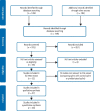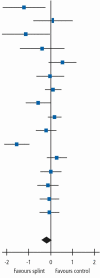Oral splints for temporomandibular disorder or bruxism: a systematic review
- PMID: 32060462
- PMCID: PMC7718146
- DOI: 10.1038/s41415-020-1250-2
Oral splints for temporomandibular disorder or bruxism: a systematic review
Abstract
Objectives To evaluate the clinical-effectiveness of oral splints for patients with TMD or bruxism for the primary outcomes: pain (TMD) and tooth wear (bruxism).Data sources Four databases including MEDLINE and EMBASE were searched from inception until 1 October 2018.Data selection and extraction Randomised controlled trials comparing all types of splints versus no/minimal treatment for patients with TMD or bruxism were eligible. Standard Cochrane review methods were used. Standardised mean differences (SMD) were pooled for the primary outcome of pain, using random effects models in TMD patients.Data synthesis Thirty-seven trials were included and the evidence identified was of very low certainty using GRADE assessments. When all subtypes of TMD were pooled into one global TMD group, there was no evidence that splints reduced pain: SMD (up to 3 months) -0.18 (95% CI -0.42 to 0.06); 13 trials, 1,076 participants. There was no evidence that any other outcomes improved when using splints. There was no evidence of adverse events associated with splints, but reporting was poor regarding this outcome. No trials measured tooth wear in patients with bruxism. There was a large variation in diagnostic criteria, splint types and outcome measures used and reported. Sensitivity analyses based on these factors did not indicate a reduction in pain.Conclusions The very low-certainty evidence identified did not demonstrate that splints reduced pain in TMD as a group of conditions. There is insufficient evidence to determine whether splints reduce tooth wear in patients with bruxism.
Conflict of interest statement
Conflicts of Interest:
There were no known conflicts of interest for any of the authors.
Figures
Comment in
-
Very low certainty evidence suggests no important benefits from using oral splints for pain in patients with specific temporomandibular disorders.J Am Dent Assoc. 2020 Sep;151(9):e77. doi: 10.1016/j.adaj.2020.03.007. Epub 2020 Jul 7. J Am Dent Assoc. 2020. PMID: 32650943 No abstract available.
References
-
- National Institute of Dental and Craniofacial Research (NIDCR). Prevalence of TMJD and its Signs and Symptoms. 2014. Available at https://www.nidcr.nih.gov/datastatistics/finddatabytopic/facialpain/prev... (accessed September 2019).
-
- Aggarwal Vishal R, Joughin Amy, Zakrzewska Joanna, Appelbe Priscilla, Tickle Martin. Dentists’ preferences for diagnosis, management and referral of chronic oro-facial pain: Results from a national survey. Health Education Journal. 2011;71(6):662–669. doi: 10.1177/0017896911419350. - DOI
-
- Higgins J T, Green S. Cochrane Handbook for Systematic Reviews of Interventions. Version 5.1.0 [updated March 2011]. The Cochrane Collaboration. Available from https://training.cochrane.org/handbook/archive/v5.1/ (accessed September 2019).
Publication types
MeSH terms
Grants and funding
LinkOut - more resources
Full Text Sources
Medical



